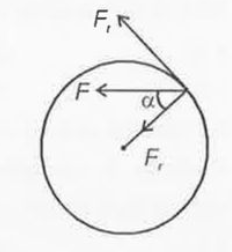The radius of the circular path of a particle is doubled but its frecuency of rotation remains unchanged . If the initial centripetal force be F, then the final centripetal force will be
(a) F
(b)F2
(c)4F
(d)2F
The correct Answer is:D
To solve the problem step by step, we will analyze the relationship between the centripetal force, radius, and frequency of rotation.
1. Understanding Centripetal Force:
The centripetal force F acting on a particle moving in a circular path is given by the formula:
F=m⋅ac
where ac is the centripetal acceleration. The centripetal acceleration can be expressed in terms of the radius r and angular velocity ω:
ac=v2r=r⋅ω2
Thus, the centripetal force can also be expressed as:
F=m⋅r⋅ω2
2. Initial Conditions:
Let the initial radius be r1 and the initial centripetal force be F. Therefore, we can write:
F=m⋅r1⋅ω2
3. Doubling the Radius:
According to the problem, the radius is doubled, so the new radius r2 is:
r2=2⋅r1
4. Frequency Remains Unchanged:
Since the frequency of rotation remains unchanged, the angular velocity ω also remains constant. Thus, we have:
ω2=ω1=ω
5. Calculating the New Centripetal Force:
The new centripetal force F2 when the radius is doubled can be expressed as:
F2=m⋅r2⋅ω2
Substituting r2:
F2=m⋅(2⋅r1)⋅ω2
This simplifies to:
F2=2⋅(m⋅r1⋅ω2)
6. Relating to Initial Centripetal Force:
From our initial condition, we know that:
F=m⋅r1⋅ω2
Therefore, substituting this into our expression for F2:
F2=2⋅F
7. Final Result:
The final centripetal force when the radius is doubled while keeping the frequency constant is:
F2=2F
Conclusion:
The final centripetal force will be 2F.
---
The centripetal force F acting on a particle moving in a circular path is given by the formula:
F=m⋅ac
where ac is the centripetal acceleration. The centripetal acceleration can be expressed in terms of the radius r and angular velocity ω:
ac=v2r=r⋅ω2
Thus, the centripetal force can also be expressed as:
F=m⋅r⋅ω2
Let the initial radius be r1 and the initial centripetal force be F. Therefore, we can write:
F=m⋅r1⋅ω2
According to the problem, the radius is doubled, so the new radius r2 is:
r2=2⋅r1
Since the frequency of rotation remains unchanged, the angular velocity ω also remains constant. Thus, we have:
ω2=ω1=ω
The new centripetal force F2 when the radius is doubled can be expressed as:
F2=m⋅r2⋅ω2
Substituting r2:
F2=m⋅(2⋅r1)⋅ω2
This simplifies to:
F2=2⋅(m⋅r1⋅ω2)
From our initial condition, we know that:
F=m⋅r1⋅ω2
Therefore, substituting this into our expression for F2:
F2=2⋅F
The final centripetal force when the radius is doubled while keeping the frequency constant is:
F2=2F
The final centripetal force will be 2F.
Topper's Solved these Questions
- Motion in Straight Line Book:VMC MODULES ENGLISHChapter:Motion in Straight Line Exercise:IN-CHAPTER EXERCISE-I
Explore 10 Videos
- MOTION IN A STRAIGHT LINE & PLANE Book:VMC MODULES ENGLISHChapter:MOTION IN A STRAIGHT LINE & PLANE Exercise:IMPECCABLE
Explore 52 Videos
- Motion in Two DimensionsBook:VMC MODULES ENGLISHChapter:Motion in Two DimensionsExercise:MCQ
Explore 2 Videos
Similar Questions
To move a body along a circular path the direction of centripetal force will be
View SolutionTwo particles are placed at some distance. If the mass of each of the two particles is doubled, keeping the distance between them unchanged, the value of gravitational force between them will be
View SolutionIf the radii of circular path of two particles are in the ratio of 1:2, then in order to have same centripetal acceleration, their speeds should be in the ratio of :
View SolutionIf the speed and radius both are trippled for a body moving on a circular path, then the new centripetal force will be:
View SolutionA particle moving in a circular path has an angular momentum of L. If the frequency of rotation is halved, then its angular momentum becomes
View SolutionA body is revolving with a constant speed along a circle. If its direction of motion is reversed but the speed remains the same, then which of the following statement is true
a. The centripetal force will not suffer any change in magnitude
b. The centripetal force will have its direction reversed
c. The centripetal force will not suffer any change in direction
d. The centripetal force would be doubled
View SolutionA charge particle is moving in a uniform magnetic field ib a circular path. The energy of the particle is doubled . If the initial radius of he circular path was R, the radius of the new circular path after the energy is doubled will be
View SolutionIf a particle of mass m is moving in a horizontal circle of radius r with a centripetal force (−1/r2) , the total energy is
View SolutionA particle of mass m is moving in a circle of radius (r) with changing speed (v) the direction of centripetal force and tangential force are shown below the value of α is

View SolutionThe speed of a body moving in uniform circular motion is doubled and the radius of the circular path is halved. What happens to the centripetal force?
View Solution